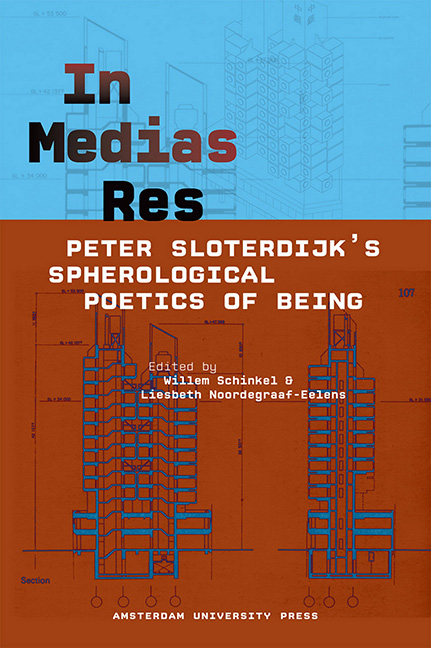Book contents
- Frontmatter
- Contents
- 1 Peter Sloterdijk’s Spherological Acrobatics: An Exercise in Introduction
- 2 Foamy Business: On the Organizational Politics of Atmospheres
- 3 “Transgenous Philosophy”: Post-humanism, Anthropotechnics and the Poetics of Natal Difference
- 4 Disinhibition, Subjectivity and Pride. Or: Guess Who Is Looking?: Peter Sloterdijk’s reconstruction of ‘thymotic’ qualities, psychoanalysis and the question of spectatorship
- 5 Sloterdijk and the Question of an Aesthetic
- 6 Uneasy Places. Monotheism, Christianity, and the Dynamic of the Unlikely in Sloterdijk’s Work – Context and Debate
- 7 The Attention Regime: On Mass Media and the Information Society
- 8 In the Beginning was the Accident: The Crystal Palace as a Cultural Catastrophe and the Emergence of the Cosmic Misfit: A critical approach to Peter Sloterdijk’s Weltinnenraum des Kapitals vs. Fyodor M. Dostoevsky’s Notes from the underground
- 9 A Cautious Prometheus? A Few Steps Toward a Philosophy of Design with Special Attention to Peter Sloterdijk
- 10 Sloterdijk and the Question of Action
- 11 The Space of Global Capitalism and its Imaginary Imperialism: An Interview with Peter Sloterdijk
- Contributors
- Index
2 - Foamy Business: On the Organizational Politics of Atmospheres
Published online by Cambridge University Press: 23 June 2021
- Frontmatter
- Contents
- 1 Peter Sloterdijk’s Spherological Acrobatics: An Exercise in Introduction
- 2 Foamy Business: On the Organizational Politics of Atmospheres
- 3 “Transgenous Philosophy”: Post-humanism, Anthropotechnics and the Poetics of Natal Difference
- 4 Disinhibition, Subjectivity and Pride. Or: Guess Who Is Looking?: Peter Sloterdijk’s reconstruction of ‘thymotic’ qualities, psychoanalysis and the question of spectatorship
- 5 Sloterdijk and the Question of an Aesthetic
- 6 Uneasy Places. Monotheism, Christianity, and the Dynamic of the Unlikely in Sloterdijk’s Work – Context and Debate
- 7 The Attention Regime: On Mass Media and the Information Society
- 8 In the Beginning was the Accident: The Crystal Palace as a Cultural Catastrophe and the Emergence of the Cosmic Misfit: A critical approach to Peter Sloterdijk’s Weltinnenraum des Kapitals vs. Fyodor M. Dostoevsky’s Notes from the underground
- 9 A Cautious Prometheus? A Few Steps Toward a Philosophy of Design with Special Attention to Peter Sloterdijk
- 10 Sloterdijk and the Question of Action
- 11 The Space of Global Capitalism and its Imaginary Imperialism: An Interview with Peter Sloterdijk
- Contributors
- Index
Summary
Introduction
One of the most intriguing parts of Peter Sloterdijk's recent work is undoubtedly his trilogy on spheres, Sphären I–III. In this spheres project, Sloterdijk offers a grand theory of our spatial embeddedness in the world. Being is simply being-inspheres, as he puts in an unmistakably Heidegger-inspired fashion, and which means that all life takes place within membranes that protect us (give us immunity and meaning). According to Sloterdijk, such membranes are always spatially situated and often even take physical spatial forms.
The three volumes of the spherology unfold life's spherical constitution on different scales. The first volume is devoted to micro-spheres, more specifically to so-called bubbles, i.e., dyadic relations that make up the tiniest possible forms of sociality. Examples of such bubbles include pair relations such as that between placenta and fetus. One of the key ideas in the analysis of bubbles is that the pair or couple is always primary to the individual. Put differently, co-subjectivity is the basis for subjectivity. The second volume in the trilogy studies macrospheres, or globes. This part of the spherology effectively offers a history of globalization, as it demonstrates how, from Greek mythology to subsequent Christian theology, the notion of the One Sphere (the One Globe, or God) formed a predominant thought-figure. Yet God's death implied the implosion of the One Sphere, which was replaced, Sloterdijk argues, with a plurality of minor spheres. The third volume of the spherology investigates this spherical diversity under the name of foams. In effect, the transition from the second to the third volumes amounts to a modernization theory; it shows how, in modern society, the belief in a grand unity has dissolved and how, in its stead, a heterogeneous social order has emerged which has no centre and which is characterized by no overarching logic. Indeed, when faced with a world of foams, we are confronted with an image of a rather fragmented society where life forms are only scantly related to one another. This is also the key message Sloterdijk conveys when he defines foam as ‘co-isolated associations’ or as ‘connected isolations’: A certain association can be identified, but in the social foam we live our lives as isolated bubbles that only share membranes with our neighbours.
- Type
- Chapter
- Information
- In Medias ResPeter Sloterdijk's Spherological Poetics of Being, pp. 29 - 42Publisher: Amsterdam University PressPrint publication year: 2012
- 1
- Cited by



